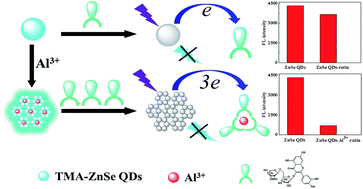当前位置:
X-MOL 学术
›
Anal. Methods
›
论文详情
Our official English website, www.x-mol.net, welcomes your
feedback! (Note: you will need to create a separate account there.)
Tuning the aggregation/disaggregation behaviours of ZnSe quantum dots for high-sensitivity fluorescent rutin sensors
Analytical Methods ( IF 2.7 ) Pub Date : 2017-08-07 00:00:00 , DOI: 10.1039/c7ay01480e Yurong Tang 1, 2, 3, 4 , Shuguang Yan 2, 5, 6, 7 , Hang Ye 2, 5, 6, 7 , Fenglan Zheng 2, 5, 6, 7 , Liu Feng 2, 5, 6, 7 , Feng Liu 2, 5, 6, 7 , Xulong Li 2, 5, 6, 7
Analytical Methods ( IF 2.7 ) Pub Date : 2017-08-07 00:00:00 , DOI: 10.1039/c7ay01480e Yurong Tang 1, 2, 3, 4 , Shuguang Yan 2, 5, 6, 7 , Hang Ye 2, 5, 6, 7 , Fenglan Zheng 2, 5, 6, 7 , Liu Feng 2, 5, 6, 7 , Feng Liu 2, 5, 6, 7 , Xulong Li 2, 5, 6, 7
Affiliation

|
The design of quantum dots as a new sensing platform is very important for developing high-sensitivity fluorescent sensors. However, achieving a new strategy is still a great challenge. Here, a new strategy for fabricating water-dispersible thiol malic acid modified ZnSe quantum dots (TMA-ZnSe QDs) is presented in aqueous solution. The characteristics of the modified TMA-ZnSe QDs and the interactions between TMA-ZnSe QDs, Al3+ and rutin were investigated by atomic force microscopy, energy dispersive X-ray spectroscopy, fluorescence spectrometry, resonance Rayleigh scattering, UV-vis absorption spectroscopy and Fourier transform infrared spectroscopy. A new high-sensitivity fluorescent sensor based on tuning the aggregation/disaggregation behavior of TMA-ZnSe QDs by structure-switching for the detection of rutin was developed. The results confirmed that the detection sensitivity was greatly improved by the aggregation of TMA-ZnSe QDs with Al3+ because rutin effectively quenched the FL of TMA-ZnSe QDs–Al3+via the photoinduced electron transfer process. Under optimum conditions, the decrease in the FL intensity was linear to the rutin concentration from 0.02 μg mL−1 to 9 μg mL−1 and the detection limit for rutin was 0.02 μg mL−1. The proposed method offered a new possibility for rutin detection in real samples owing to its low cost, simplicity, high sensitivity and good stability. The present work provides a new strategy for improving sensitivity by tuning the aggregation/disaggregation behavior of TMA-ZnSe QDs.
中文翻译:

调整ZnSe量子点的聚集/解聚行为以用于高灵敏度荧光芦丁传感器
量子点作为新的传感平台的设计对于开发高灵敏度荧光传感器非常重要。但是,实现新策略仍然是巨大的挑战。在此,提出了一种在水溶液中制备水分散性巯基苹果酸修饰的ZnSe量子点(TMA-ZnSe QDs)的新策略。改性TMA-ZnSe量子点的特性以及TMA-ZnSe量子点与Al 3+之间的相互作用通过原子力显微镜,能量色散X射线光谱,荧光光谱,共振瑞利散射,紫外可见吸收光谱和傅里叶变换红外光谱研究了芦丁和芦丁。开发了一种新的高灵敏度荧光传感器,该传感器基于结构开关调节TMA-ZnSe量子点的聚集/解离行为,用于检测芦丁。结果证实,TMA-ZnSe QDs与Al 3+的聚集大大提高了检测灵敏度,因为芦丁通过光致电子转移过程有效地淬灭了TMA-ZnSe QDs-Al 3+的FL 。在最佳条件下,FL强度的降低与芦丁浓度(从0.02μgmL -1开始)呈线性关系至9μgmL -1,芦丁的检出限为0.02μgmL -1。该方法成本低,操作简便,灵敏度高,稳定性好,为实际样品中芦丁的检测提供了新的可能。本工作提供了一种新的策略,可通过调整TMA-ZnSe量子点的聚集/解离行为来提高灵敏度。
更新日期:2017-09-21
中文翻译:

调整ZnSe量子点的聚集/解聚行为以用于高灵敏度荧光芦丁传感器
量子点作为新的传感平台的设计对于开发高灵敏度荧光传感器非常重要。但是,实现新策略仍然是巨大的挑战。在此,提出了一种在水溶液中制备水分散性巯基苹果酸修饰的ZnSe量子点(TMA-ZnSe QDs)的新策略。改性TMA-ZnSe量子点的特性以及TMA-ZnSe量子点与Al 3+之间的相互作用通过原子力显微镜,能量色散X射线光谱,荧光光谱,共振瑞利散射,紫外可见吸收光谱和傅里叶变换红外光谱研究了芦丁和芦丁。开发了一种新的高灵敏度荧光传感器,该传感器基于结构开关调节TMA-ZnSe量子点的聚集/解离行为,用于检测芦丁。结果证实,TMA-ZnSe QDs与Al 3+的聚集大大提高了检测灵敏度,因为芦丁通过光致电子转移过程有效地淬灭了TMA-ZnSe QDs-Al 3+的FL 。在最佳条件下,FL强度的降低与芦丁浓度(从0.02μgmL -1开始)呈线性关系至9μgmL -1,芦丁的检出限为0.02μgmL -1。该方法成本低,操作简便,灵敏度高,稳定性好,为实际样品中芦丁的检测提供了新的可能。本工作提供了一种新的策略,可通过调整TMA-ZnSe量子点的聚集/解离行为来提高灵敏度。











































 京公网安备 11010802027423号
京公网安备 11010802027423号